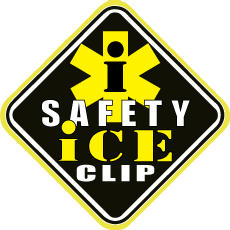What is a “Safety ICE Clip?”
The acronym I.C.E. stands for “in case of emergency”.
The safety ICE clip is a small plastic case that easily attaches to your seatbelt, to the strap of a child’s backpack, to many waist belts, purses, baby seat straps, camelbacks for bikers and runners, and to similar surfaces. Within that clip at two cards which provide emergency information to first responders in case of illness or accident.
Why do I need that information in my car or on my backpack?
The safety ICE clip was developed by two emergency responders with plenty of experience in dangerous or life-threatening situations.
While no one likes to imagine themselves caught in a dangerous situation after an accident, it’s always wise to be prepared.
Usually, when your paramedics and EMTS arrive on the scene of an accident, they have to waste precious time searching for ID and information about the person they’re treating.
They also have to invest critical time searching out an emergency contact for the person needing help.
In addition to knowing someone’s name and age for treatment, they often may need to know about allergies, especially to medications, and relevant health issues, as well as blood type.
Immediate listing of family or business contacts becomes crucial as well, as they work to get the ill or injured individual proper treatment.
The cards in the safety ICE clip, which can be downloaded from this website, provide all the information first responders need to make sure you get the best and safest treatment for you.
With that information at their fingertips, they can safely treat the injured person almost immediately.
Currently, the creators of the ICE clip are also working on handle holders for motorcycles and bicycles as well.
Can you give me some examples of how this information is instantly useful?
Sure! If someone has a head injury, for example, if the EMT can immediately ask his name, age and address, then he or she will quickly be able to determine how that injury has affected the individual’s understanding. The same technique can be used when stroke is suspected.
If a child has an allergy to a particular drug, the information in the ICE clip card can keep responders from making the mistake of giving it to him.
If the individual is diabetic and he is unresponsive, the card alerts a responder to check his blood sugar without hesitation.
If an individual is similarly unresponsive and may have had a stroke, but the EMT knows from the clip he isn’t diabetic, but he has high blood pressure, the responder then knows to evaluate blood pressure straight away to determine whether he’s had a stroke.
If you have an elderly relative or someone in your family with a chronic health condition, the ICE clip can provide plenty of important details in case of emergency.
For example, a clip on the belt of an Alzheimer’s patient can allow rescuers to quickly identify him if he wanders from home and get him back safely.
In each case, knowing the critical details immediately means the first responders don’t have to worry about guesswork in treating the injured or ill individual.
